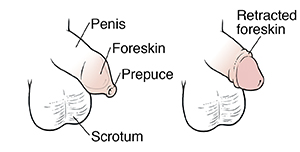When Your Child Has Phimosis
When Your Child Has Phimosis

Understanding phimosis
In uncircumcised boys, the foreskin lies over the head of the penis. It starts to loosen from the head of the penis by age 3. This allows the foreskin to gently retract (slide back) over the head of the penis. In some boys, the tip of the foreskin (prepuce) is very tight, making it difficult to retract. This is phimosis.
What causes phimosis?
The exact cause of phimosis is not known. It is most likely to be identified in boys between the ages of 4 and 7.
How is phimosis diagnosed?
Phimosis is easily diagnosed during an exam. For the exam, the healthcare provider will need to look at and handle your child’s penis. You can help make your child more comfortable by reassuring him that this is OK.
How is phimosis treated?
To treat phimosis, the healthcare provider may recommend:
Slow, gentle retraction of the foreskin. You will be taught how to do this at home.
A prescription steroid cream. The cream helps to promote skin loosening. Your healthcare provider will show you how to use it.
Circumcision (removal of the foreskin). This may be recommended if your child’s phimosis is severe.
What are the long-term concerns?
If phimosis is not treated, it can cause problems as your child gets older. The flow of urine from the penis may become blocked. This can make urination messy or difficult, and may increase the risk for infection because of trapped urine.
It is important to understand that uncircumcised boys may be at greater risk of certain medical problems, including balanitis and other infections of the penis. This is because of the buildup of dead cells under the foreskin and the resulting poor hygiene. Uncircumcised boys may also be at greater risk of cancers.
When to call your healthcare provider
Call your child’s healthcare provider if your child has any of the following:
Foreskin is retracted and will not go back over the tip of the penis (paraphimosis)
Bleeding from the foreskin
Pain during foreskin retraction
Redness or swelling of the penis
Any discharge from the foreskin
Updated:
April 28, 2017
Sources:
Care of the Uncircumcised Penis,s Up To Date, McGregor, TB. Pathologic and Physiologic Phimosis, Canadian Family Physician (2007); 53; pp. 445-448, Morris, BJ, The Strong Protective Effect of Circumcision Against Cancer of the Penis, Advances in Urology (2018); 81236; pp. s1-s21
Reviewed By:
Image reviewed by StayWell medical illustration team.,MMI board-certified, academically affiliated clinician,Turley, Ray, BSN, MSN